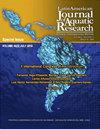黄线箭蜘蛛蟹(短肢目:蜘蛛蟹科)在Bahía de La Paz Baja California Sur的产卵特性
IF 0.8
4区 农林科学
Q3 FISHERIES
Latin American Journal of Aquatic Research
Pub Date : 2023-02-28
DOI:10.3856/vol51-issue1-fulltext-2945
引用次数: 0
摘要
加利福尼亚湾西南部是世界各地交易的观赏海洋物种的重要来源,其中Stenorhynchus debilis蜘蛛蟹很受欢迎。然而,人们对物种生物学和生态学知之甚少。这项研究将在墨西哥拉巴斯湾采集的年轻产卵雌性(共28只)放入每3-4个月清洗一次的双壳类海水养殖装置中。分析了总壳长(TL)和壳宽(CW)、无卵重量(TW)和繁殖力(F,卵数)的多重关系。F分为162个和2205个鸡蛋(x̄=1171±689个鸡蛋),直径为0.38至0.45毫米(x̃=0.396±0.027毫米)。检测到三种持续的交互模式:低/中/高F、小/中/大尺寸(TL和CW)和轻/中/重TW。应用对数线性化异速回归法根据肤色确定相对繁殖力常数(RFC),发现TL和CW之间与等腰甲上的逐步生长和尺寸分类具有高度平行性。相比之下,TW表示跨层间阶段的肤色增加。在螃蟹第一龄后的3-4个月内,S.debilis可能完成三个成熟/蜕皮周期。RFC值通过肤色证实了积极的趋势,其中卵子大小和F与物种大小和形状有关,在本研究案例中确立了权衡比例。本文章由计算机程序翻译,如有差异,请以英文原文为准。
Fecundity traits of young ovigerous females of yellow-line-arrow spider crab Stenorhynchus debilis (Brachyura: Inachoididae) in Bahía de La Paz Baja California Sur, México
The southwestern Gulf of California is an important source of ornamental marine species traded worldwide, wherein spider crabs Stenorhynchus debilis are popular items. However, little is known about species biology and ecology. This study involves young ovigerous females (28 in total) recollected at Bahía de La Paz, Mexico, into bivalve mariculture devices cleaned every 3-4 months. Total carapace length (TL) and carapace width (CW), weight without eggs (TW), and fecundity (F, number of eggs) were analyzed for multiple relationships. F varied into 162 and 2205 eggs (x̄ = 1171 ± 689 eggs), their diameter into 0.38 to 0.45 mm (x̄ = 0.396 ± 0.027 mm). Three persistent and interactive modes were detected: low/moderate/high F, small/medium/large size (TL and CW), and light/middle/heavy TW. Log-linearized allometric regressions were applied to determine the relative fecundity constants (RFC) by body complexion, finding high parallelism between TL and CW related to step-wise growth and size categorization upon the isosceles-shaped carapace. In contrast, TW denoted an increase in body complexion across intermolt phases. S. debilis likely completes three maturation/molt cycles within 3-4 months after the first crab instar. RFC values confirmed positive trends by body complexion where egg size and F are related to species size and shape, establishing the trade-off proportions in this study case.
求助全文
通过发布文献求助,成功后即可免费获取论文全文。
去求助
来源期刊

Latin American Journal of Aquatic Research
FISHERIES-MARINE & FRESHWATER BIOLOGY
CiteScore
1.70
自引率
10.00%
发文量
44
审稿时长
4-8 weeks
期刊介绍:
Latin American Journal of Aquatic Research- LAJAR is the continuation of the journal Investigaciones Marinas (1970-2007) and is published since 2008 by the Escuela de Ciencias del Mar, Facultad de Ciencias del Mar y Geografía of the Pontificia Universidad Católica de Valparaíso. LAJAR is an “Open Access” journal that publishes in English language, original research articles, reviews and short communications on aquatic science, which contain the results of research conducted in aquaculture or in oceanic and coastal marine waters of Latin America.
The following topics are considered: Physical Oceanography, Chemical Oceanography, Marine Biogeochemistry, Marine Pollution and Toxicology, Marine Geology and Geophysics, Biological Oceanography, Fisheries and Aquaculture.
 求助内容:
求助内容: 应助结果提醒方式:
应助结果提醒方式:


